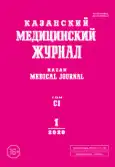Influence of various methods of hernia repair on the state of blood flow in the vessels of the spermatic cord and germination function of the testicle in men with inguinal hernias
- Authors: Guseynova GT1
-
Affiliations:
- Azerbaijan Medical University
- Issue: Vol 101, No 1 (2020)
- Pages: 132-138
- Section: Clinical experiences
- URL: https://journals.rcsi.science/kazanmedj/article/view/20399
- DOI: https://doi.org/10.17816/KMJ2020-132
- ID: 20399
Cite item
Full Text
Abstract
Aim. Study of the influence of various methods of hernia repair (auto- and allo-) on testicular blood supply and hormonal background in mature men with inguinal hernias.
Methods. Among 82 male patients aged 18–60 years with various clinical forms of inguinal hernias, the effect of Trabucco allohernioplasty (20 patients) on the blood supply and reproductive function of the testicles was studied in comparison with Girard (19 patients) and Postempskiy autohernioplasty (22 patients), as well as Lichtenstein alloplasty (21 patients) in dynamics before and after 1, 6 and 12 months after surgery. The linear velocity of blood flow in the testicular artery (a. testicularis) was determined at the point of its exit as part of the spermatic cord from the outer ring of the inguinal canal using the ultrasonic diagnostic system using a linear sensor with a scanning frequency of 7.5 MHz. After identification of the testicular artery, the systolic linear velocity of blood flow in this artery was determined on the side of hernial protrusion, as well as on the intact side. At the same time, the concentration of total testosterone in the peripheral blood was studied by the ELIZA method.
Results. In the postoperative period (for 1 year) we recorded a decrease in linear velocity of blood flow in comparison with the baseline preoperative level in patients with inguinal hernias after all methods of hernioplasty. However, the greatest decrease of linear velocity of blood flow was observed afer local tissue hernioplasty by Girard (by 2.8 cm/sec, 14.9%; p <0.01) and by Postempskiy (by 3.4 cm/sec, 17.5%), and the least — after alloplasty by Lichtenstein (by 0.5 cm/sec, 2.7%; p >0.05) and alloplasty by Trabucco (by 0.1 cm/sec, 0.5%; p >0.05). It was revealed that in patients (men) with inguinal hernias, testosterone level in the blood 1 year after autohernioplasty by Postempsky significantly (p <0.01) decreased by 6.8%, after autoplasty by Girard — by 4.3% (p <0.05), after hernioalloplasty by Lichtenstein — by 3.4% (p <0.05). At the same time, after Trabucco allohernioplasty, a decrease in the level of testosterone in the blood did not occur, and, on the contrary, a non-significant (p >0.05) trend of its increased production by 0.5% 12 months after surgery was revealed.
Conclusion. The studied methods (especially autoplasty by Postempskiy and Girard) have a pronounced negative impact on the blood supply and the germination function of testicles with significant reduction in the concentration of testosterone in the blood; except allohernioplasty according to the method of Trabucco, after which along with the smallest flow reduction (by 0.5%; p >0.05) no increase of the concentration of this hormone occurs.
Full Text
##article.viewOnOriginalSite##About the authors
G T Guseynova
Azerbaijan Medical University
Author for correspondence.
Email: nauchnayastatya@yandex.ru
Azerbaijan, Baku, Azerbaijan
References
- Askerkhanov G.R. Aytekova F.M. The effect of different hernia repair methods on quality of life and fertility of patients. Novosti khirurgii. 2014; (5): 538–546. (In Russ.)
- Sobennikov I.S., Zhiborev B.N., Kotans S.Ya., Cherenkov A.A. Diagnosis and treatment of male infertility in patients with common pathology of genitals and inguinal region. Rossiyskiy mediko-biologicheskiy vestnik im. akademika I.P. Pavlova. 2017; 25 (3): 460–464. (In Russ.)
- Kul'chenko N.G. Inguinal hernia repair and male health. Issledovaniya i praktika v meditsine. 2019; 6 (3): 65–73. (In Russ.)
- Griculjak B.V., Griculjak V.B., Hallo O.Je. Stan makro- ta mіkrocirkuljatornogo rusla і parenhіmi jaєchka u cholovіkіv reproduktivnogo vіku v umovah prjamoї pahvinnoї grizhі. Galic'kij lіkars'kij vіsnik. 2010; 17 (1): 26–27.
- Solov'ev A.A., Sahashhik M.N., Popkova S.V., Astrakhantsev A.F. Features of testicular blood flow and pathogenetic aspects of impaired fertility in patients with inguinal hernias. Vestnik khirurgii im. I.I. Grekova. 2009; (3): 103–106. (In Russ.)
- Kohl A.P., Andresen K., Rosenberg J. Male fertility after inguinal hernia mesh repair A National Register Study. Ann. Surg. 2018; 268 (2): 374–378. doi: 10.1097/SLA.0000000000002423.
- Gvenetadze T.K., Giorgobiani G.T., Archvadze V.Sh., Gulbani L.O. Prevention of male infertility development after different methods of inguinal hernia repair with the mesh explant. Novosti khirurgii. 2014; (3): 379–385. (In Russ.)
- Dong Z., Kujawa S.A., Wang C., Zhao H. Does the use of hernia mesh in surgical inguinal hernia repairs cause male infertility? A systematic review and descriptive analysis. Reprod. Health. 2018; 15 (1): 69. doi: 10.1186/s12978-018-0510y.
- Klimov A.E., Popov V.S., Barkhudarov A.A., Yuriy A.V. Choice of mesh implants for Lichtenstein plastic of male in reproductive age. Vestnik Rossiyskogo universiteta druzhby narodov. Seriya: Meditsina. 2018; 22 (3): 249–257. (In Russ.)
- Chistyakov D.B., Movchan K.N., Yashchenko A.S. Experience differentiated application of modern surgical technologies for the treatment of patients with inguinal hernias. Sovremennye problemy nauki i obrazovaniya. 2015; (4): 348. (In Russ.)
- Huerta S. Inguinal hernia repair in centers of excellence. Hernia. 2019, Jul. 5. (Epub ahead of print.) doi: 10.1007/s10029-019-01998-6.
- Heymann F., von Trotha K.T., Preisinger C. et al. Polypropylene mesh implantation for hernia repair causes myeloid cell-driven persistent inflammation. JCI Insight. 2019; 4 (2): e123862. doi: 10.1172/jci. insight.123862.
- Festa V., Rollino R., Baracchi F. et al. Use of the “flat mesh” T4r in the Trabucco inguinal hernioplasty. Technical note. Minerva. Chir. 2002; 57 (5): 707–710.
- Testini M., Miniello S., Piccinni G. et al. Trabucco versus Rutkow versus Lichtenstein techniques in the treatment of groin hernia. A controlled randomized clinical trial. Minerva. Chir. 2002; 57 (3): 371–376. PMID: 12029233.
- Fedorov A.L., Fedorov I.V., Pozdeev O.K. Inguinal hernia, plastic according to Trabucco. Prakticheskaya meditsina. 2011; 11 (2): 23–25. (In Russ.)
Supplementary files






